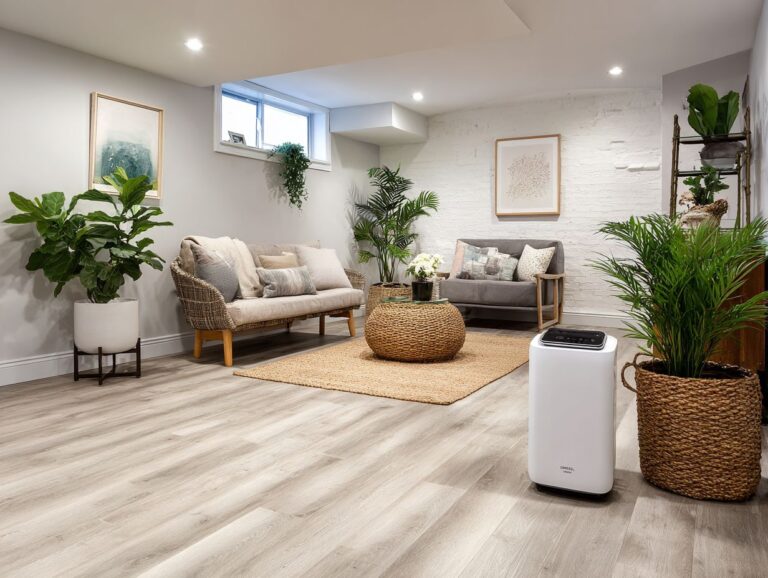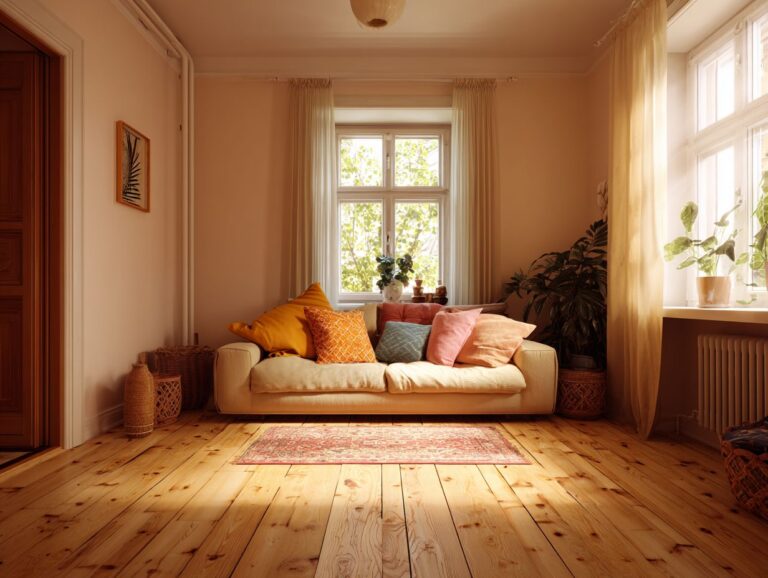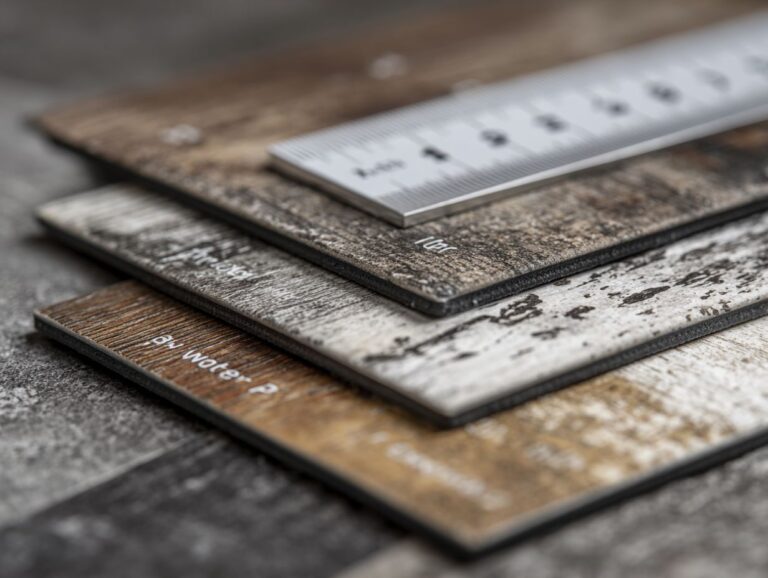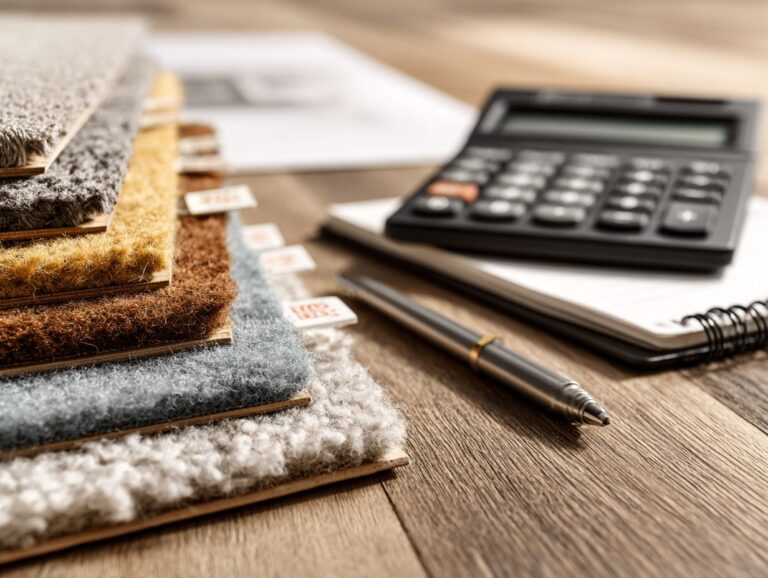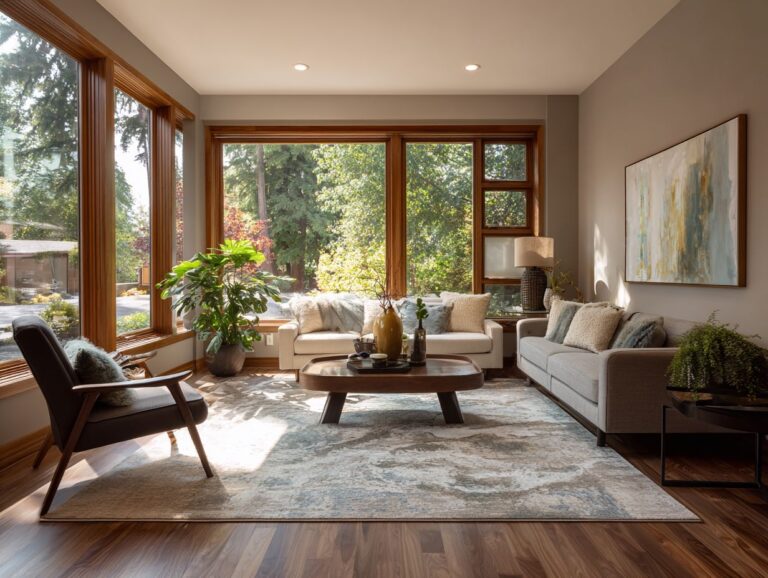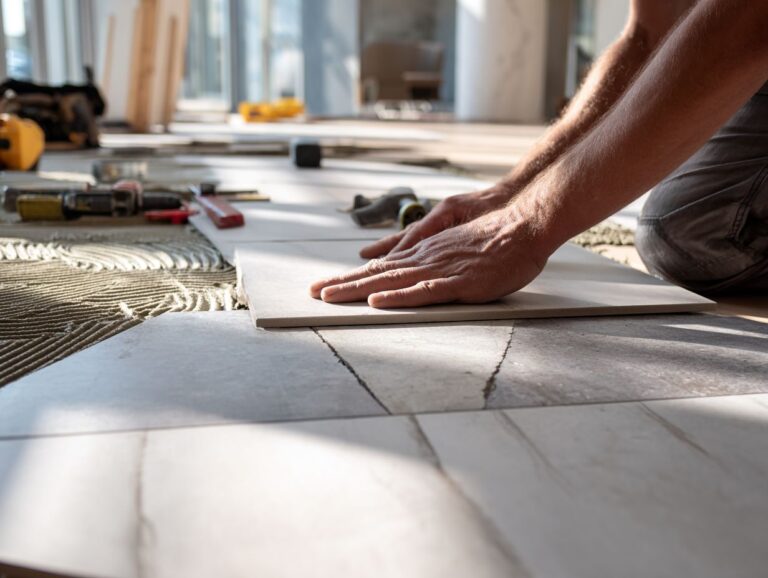Hardwood Floor Cupping and Crowning – Causes and Fixes
Hardwood floors can make any room look better, but problems like cupping and crowning can spoil their appearance. Cupped floors, caused by moisture issues, lead to uneven surfaces, while crowned floors present a different challenge altogether. Knowing these issues and how to fix them is key to keeping your hardwood floors in good condition. In this article, we will look at why floors become cupped and crowned, and offer practical advice on how to fix cupped floors, helping your hardwood look great for many years.
Key Takeaways:
Contents
Definition of Cupping and Crowning
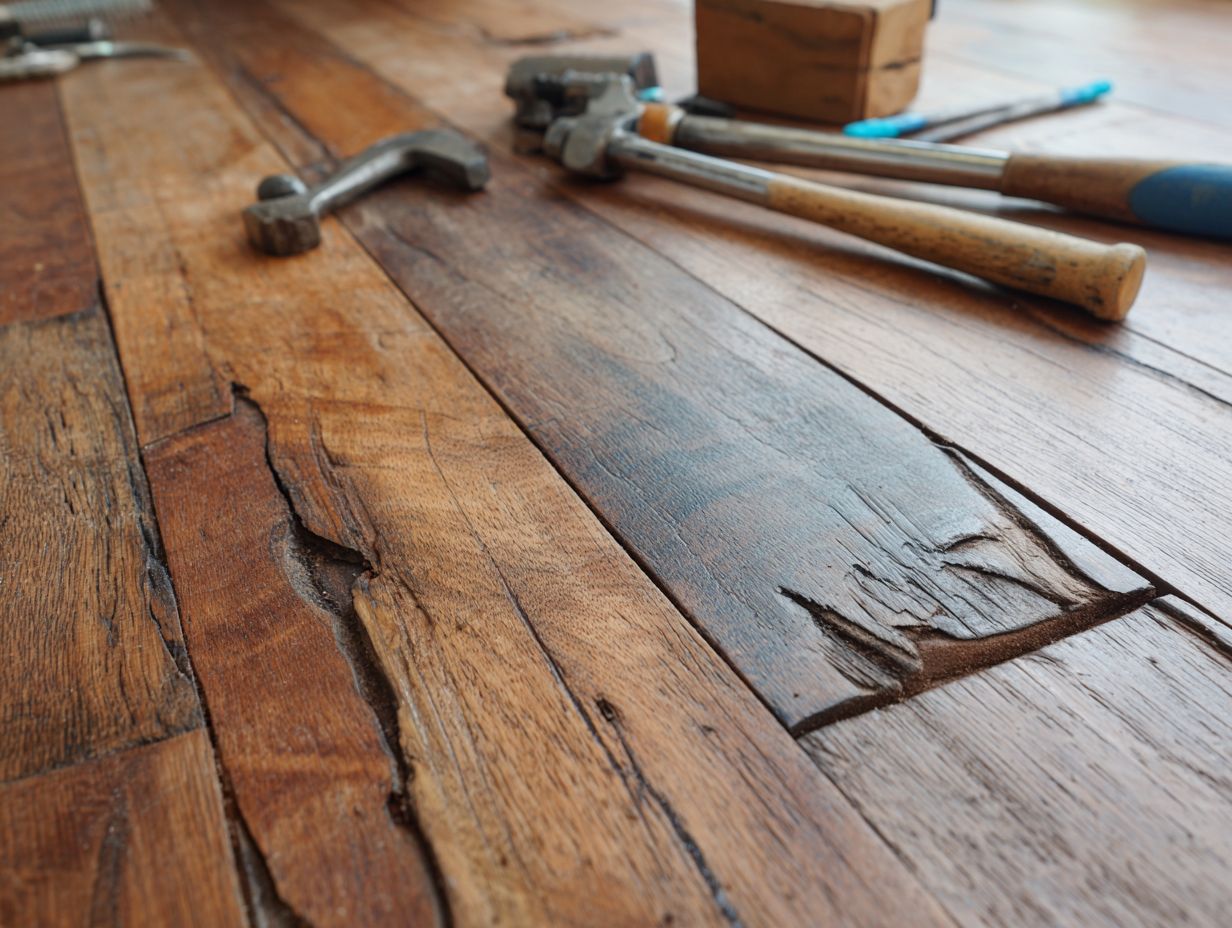
Cupping happens when the sides of hardwood planks are higher than the middle. Crowning happens when the middle part is higher. Both point to problems with moisture.
It’s important to spot and fix these issues quickly to protect your floors. To assess cupping, check for gaps between planks; if they are prominent, moisture may be trapped below.
For crowning, use a straightedge to determine if the center rises significantly. Tools like a moisture meter can measure the humidity levels in the wood and surrounding environment. If moisture is the issue, consider using a dehumidifier or improving ventilation.
Addressing these signs early can prevent costly repairs and extend the lifespan of your hardwood floors.
Importance of Addressing These Issues
Ignoring these issues might result in costly repairs or even the need for full replacement. For example, a homeowner in Florida delayed fixing cupping floors, leading to extensive moisture damage that cost over $15,000 to rectify.
To tackle these issues in advance, think about using a humidifier to control moisture in your home or a high-quality moisture meter to check conditions before major damage happens.
Regular maintenance, such as refinishing every 5-10 years, can prevent these issues from worsening.
Understanding Cupping
Cupping in hardwood floors happens often due to uneven moisture levels, which causes visible alterations in the floor’s look and feel.
What is Cupping?
Cupping is defined as the upward bending of wood planks due to uneven moisture absorption, causing edges to rise and centers to dip.
This phenomenon occurs because wood is hygroscopic, meaning it absorbs moisture from the environment. When one side of a plank is exposed to higher humidity, it swells unevenly.
For instance, if a wood floor is installed over an unsealed crawl space, moisture can enter from below, leading to cupping. To avoid this problem, make sure the area has good airflow and manages moisture levels well.
Regularly using a dehumidifier or installing a vapor barrier can help stabilize moisture levels, keeping floors flat and functional.
Common Causes of Cupping
Key contributors to cupping include high humidity levels, water leaks, and improper acclimation of wood prior to installation.
Other causes of cupping are inadequate ventilation and fluctuations in temperature. For instance, wood installed in a humid environment can absorb moisture, leading to warping, especially if not acclimated properly.
To keep track of conditions, using a moisture meter is important; these tools help confirm that wood moisture content stays between 6-12%. Regularly checking humidity with a hygrometer can stop cupping from happening later.
Addressing ventilation issues in your house can further mitigate risks, ensuring that wood remains stable and durable over time.
Signs and Symptoms of Cupping
Visible signs of cupping include warped edges, uneven surface texture, and changes in the sound when walking on the floor.
To identify cupping in hardwood floors, homeowners should examine the planks closely. Look for edges that appear raised or dished downwards, creating a noticeable dip in the center.
Pay attention to how the floor feels underfoot; a shifting or hollow sound could indicate underlying moisture issues. Checking moisture levels with a hygrometer can be helpful; readings above 12% can suggest excessive dampness.
Regularly inspecting your flooring after heavy rains or spills will help catch problems early, allowing for timely repairs and maintenance.
Impact of Cupping on Hardwood Floors
Cupping can cause serious problems like weak joints and potential subfloor damage, which may lead to expensive repairs.
The average repair cost for cupped hardwood floors can range from $1,000 to $3,500, significantly depending on the extent of damage and the region.
Repair challenges often include refinishing, which typically costs about $3 to $5 per square foot, or even replacing sections of flooring. If cupping is due to moisture issues, you may need to invest in remediation, adding another $500 to $2,000 to the bill.
Regular upkeep and quickly fixing moisture issues can reduce these risks and keep your floor in good condition.
Hardwood Floor Damage Statistics
Hardwood Floor Damage Statistics
The Hardwood Floor Damage Statistics The data set is missing certain numerical details. Even without specific data, the title itself draws attention to important aspects related to hardwood floor damage, including its reasons, how common it is, and what it might mean for homeowners and the flooring business.
Hardwood floors are a popular choice for many due to their durability, aesthetic appeal, and value addition to properties. However, they can be damaged. Common issues affecting hardwood floors include:
- Moisture and Water Damage: Excessive exposure to moisture from spills, leaks, or high humidity can lead to warping, cupping, or buckling of hardwood floors. This kind of damage is particularly problematic in areas like kitchens, bathrooms, or basements.
- Scratches and Dents: Hardwood floors can be susceptible to scratches from furniture, pet claws, or even certain types of footwear. Dents can occur from heavy objects being dropped or moved across the floor.
- Sunlight Exposure: Prolonged exposure to direct sunlight can cause discoloration or fading of hardwood floors, impacting their visual appeal.
- Wear and Tear: Over time, high traffic areas may show signs of wear, including thinning of the finish or surface roughness, necessitating refinishing or replacement.
Knowing how common these types of damage are and what causes them can help homeowners with upkeep and help the flooring industry create stronger products. For example, options like engineered wood with a strong coating can provide better protection against water and scratches.
While the current dataset doesn’t provide specific statistics, awareness of these common issues is critical. Homeowners should consider preventive measures like using rugs in high-traffic areas, controlling indoor humidity, and regularly cleaning and inspecting their hardwood floors to mitigate damage. Continuous improvements in materials and finishes can make hardwood flooring last longer and withstand wear better, effectively meeting consumer needs.
Understanding Crowning
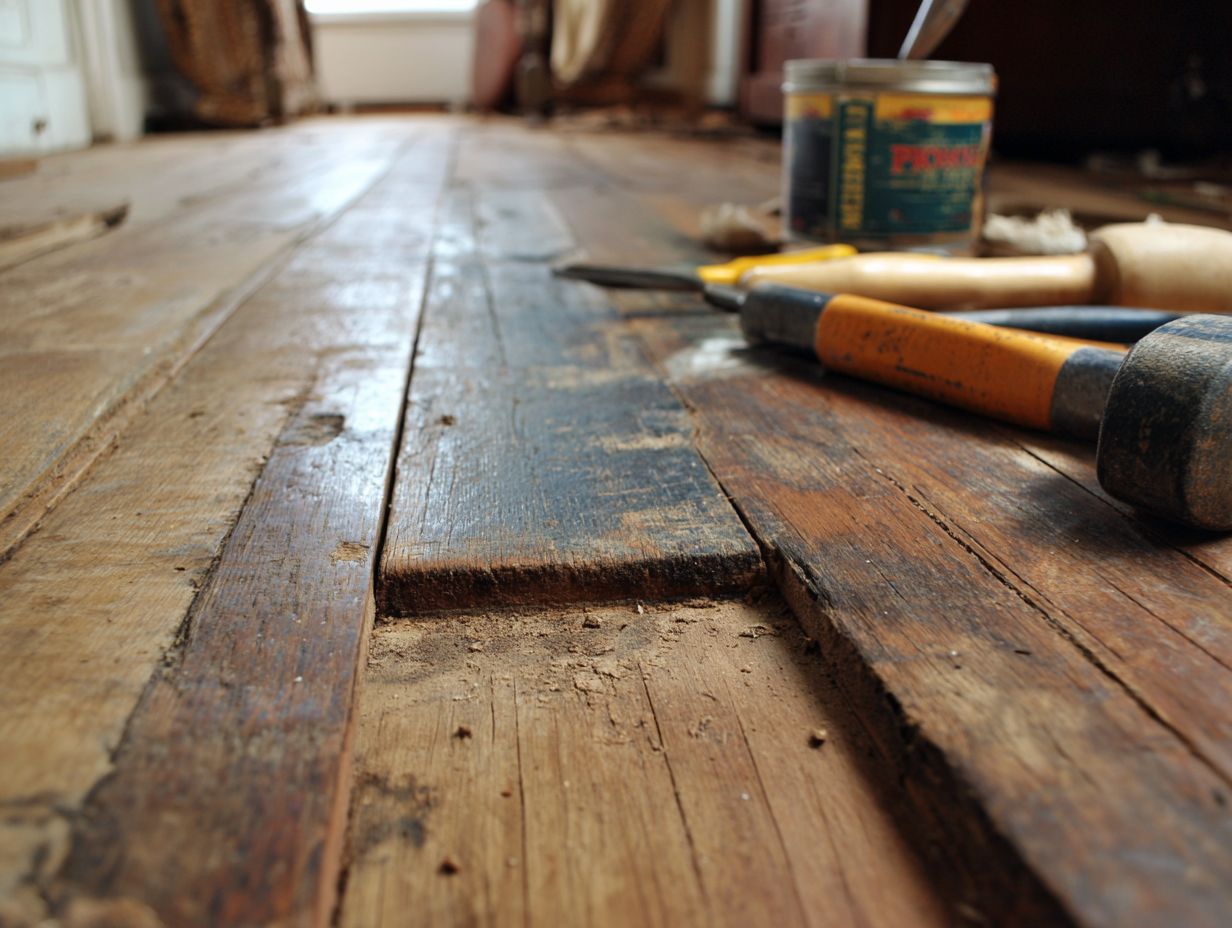
Crowning happens when the middle part of hardwood planks bends upwards, usually because of too much moisture underneath.
It is often confused with cupping.
What is Crowning?
Crowning is defined as the upward bulging of the center of hardwood planks, often resulting from moisture issues or subfloor problems.
To address crowning, first, assess the source of moisture. Use a moisture meter to check humidity levels in the planks and subfloor.
If moisture is high, consider employing a dehumidifier to alleviate excess dampness. Evaluate the subfloor for unevenness. If needed, use a leveling compound to create a flat surface.
Once the moisture issue is resolved, sand the raised boards thoroughly until they are level, ensuring the surface appears uniform. Regular maintenance, like checking the moisture levels inside, can stop problems from happening later.
Common Causes of Crowning
Common causes of crowning include excessive moisture from the subfloor, poor HVAC control, and high relative humidity levels.
To prevent crowning, first control humidity by monitoring it with a hygrometer; aim for 30-50% relative humidity.
Next, make sure to let air circulate by turning on exhaust fans and opening windows when the weather allows. Regularly service your HVAC system to maintain stable temperature and humidity levels.
Manage your subfloor moisture by using a vapor barrier in crawl spaces and basements. Using these strategies will reduce major risks and extend the lifespan of your hardwood floors.
Signs and Symptoms of Crowning
Crowning signs might show as a raised area in the middle of the boards, noises when stepped on, and visible spaces at the edges.
To confirm crowning, use a straightedge to assess the flatness of your flooring. Place the straightedge across the plank, noting any gaps between it and the floor. A gap of more than 1/8 inch indicates a problem.
Check for uneven wear on the wood surface and water damage, which are common culprits. Regular humidity control, ideally between 30-50%, can prevent these issues.
Investing in a dehumidifier may be necessary in damp environments, while fans or air conditioning can help during dry spells.
Impact of Crowning on Hardwood Floors
Crowning can compromise the integrity of hardwood floors, leading to costly repairs and potential damage to the underlying subfloor.
Over time, crowned floors can have serious issues, like gaps and squeaking, that need major repairs.
For instance, a case study showed that a homeowner faced $4,000 in repairs due to rotting subflooring after neglecting crowning signs. Regular inspections, especially in climates with high humidity fluctuations, can help identify issues early.
Homeowners should also consider investing in moisture meters to monitor humidity levels and use dehumidifiers when necessary. By following these steps, you can extend the lifespan of hardwood floors and lower repair expenses.
Environmental Factors
Knowing environmental factors is important to prevent cupping and crowning, as both moisture and temperature changes are significant. For more insights, see also our guide on hardwood floor thickness which can influence how these factors affect your flooring.
Humidity and Moisture Levels
Keeping humidity between 30% and 50% is important, as different levels can cause moisture issues that affect the floor.
To get exact humidity measurements, buy a Wagner Meters moisture meter for reliable results.
For immediate adjustments, consider using a dehumidifier for high humidity or a humidifier during dry seasons. Regularly checking humidity levels can prevent issues like warping or cracking in wooden floors.
Measure humidity at various times during the day because it can change with temperature differences. Changing these things can greatly increase how long your flooring lasts and keeps the indoor space pleasant.
Temperature Fluctuations
Temperature changes can cause hardwood to expand and contract, exacerbating issues like cupping and crowning if not properly managed.
To maintain a stable indoor climate and protect your hardwood floors, consider using a reliable HVAC system. Set the thermostat to keep the indoor temperature between 60-80 degreesF and humidity levels between 30-50%.
Investing in a hygrometer can help monitor moisture levels. Make use of programmable thermostats to adjust temperatures during different times of the day.
Regular upkeep of your HVAC system, like changing air filters and cleaning ducts, will help it run well, keeping your home comfortable.
Improper Installation Techniques
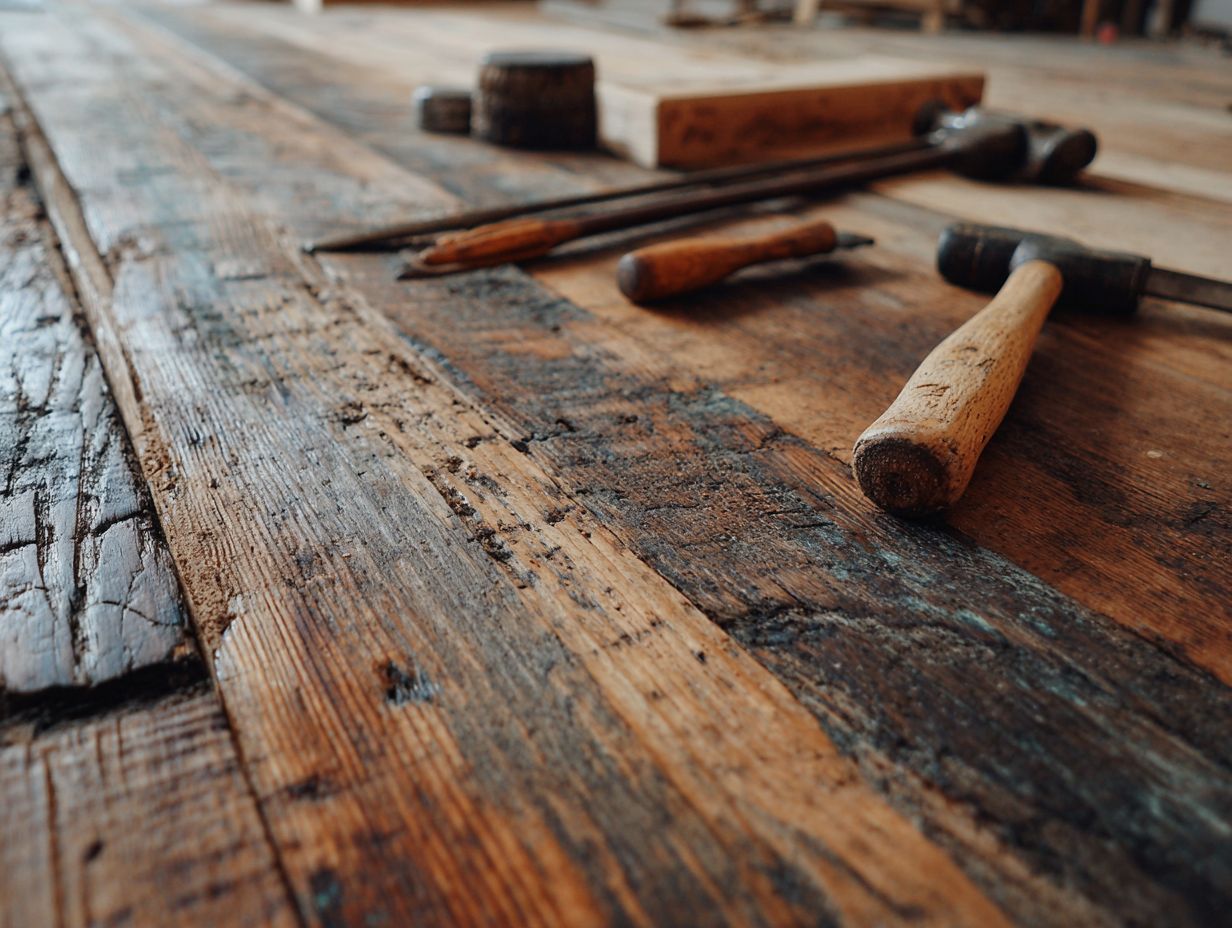
Poor installation practices, such as inadequate expansion gaps or failing to acclimate wood, can lead to significant flooring issues over time.
To avoid these pitfalls, consider these best practices:
- First, allow hardwood planks to acclimate in the room for at least 48 hours to adjust to humidity levels.
- Next, leave at least a 1/4 inch space around the edges to allow for changes in size due to season changes.
- Use a moisture meter to measure the subfloor moisture before installation, ensuring it’s below 12%.
By following these steps, you create a stable foundation that minimizes warping and buckling problems later on.
Preventative Measures
Preventive measures can significantly reduce the risk of cupping and crowning, helping hardwood floors stay in good condition.
Maintaining Proper Humidity
To maintain proper humidity, use a dehumidifier or humidifier, keeping indoor levels between 30-50% as measured by a moisture meter.
For effective humidity control, consider using a hygrometer like the AcuRite 00613 or the Govee H5075, which provide real-time measurements.
If humidity exceeds 50%, a dehumidifier like the hOmeLabs 50 Pint can help, while a humidifier such as the TaoTronics TT-AH001 is excellent for dry environments.
Regularly inspect your HVAC system to make sure it works correctly because it can greatly impact indoor humidity levels. Keeping windows closed on humid days also helps maintain your desired range.
Regular Maintenance Practices
Regular maintenance, including cleaning and periodic refinishing, can extend the life of hardwood floors and prevent moisture-related problems.
To maintain hardwood floors effectively, follow this simple checklist:
- Clean weekly with a damp microfiber mop to remove dust and dirt.
- Apply a pH-neutral cleaner monthly to prevent buildup.
- Check the surface every 6-12 months. If it looks worn, think about reapplying the finish.
- Avoid harsh chemicals and excessive water, as they can damage the wood.
- Use coasters under furniture and place mats at entryways to minimize scratches and wear.
Regularly tending to these tasks can keep your floors looking beautiful for years.
Choosing the Right Wood Species
Selecting wood species with suitable moisture resistance can significantly influence the performance of your hardwood floors in varying climates.
Different species change in response to moisture and humidity levels in their own ways, which directly impacts how long they live and how they look.
For example, oak is recognized for its strong durability, holding its shape even in damp environments. In contrast, maple tends to be less stable, which can lead to warping over time. Cherry, while beautiful, is more susceptible to changes in moisture, requiring careful humidity management.
Knowing these characteristics helps homeowners pick woods that match their style and last in their particular surroundings.
Fixing Cupping and Crowning
Solving issues like cupping and crowning in hardwood floors involves both immediate repairs and ongoing solutions to bring them back to their original state. It’s essential to start with proper subfloor preparation to ensure long-lasting results. For more detailed steps, refer to our Subfloor Preparation – Leveling and Repair Guide.
Short-Term Solutions
Short-term solutions for cupped floors may include reducing humidity, using fans to expedite drying, and applying weight to flatten boards.
To lower humidity, use a dehumidifier to keep it between 30-50%. Place fans in different parts of the room to help the air move better, aiming for a cross breeze to help things dry faster.
For the weight application, consider placing heavy objects, like books or gym weights, directly on the cupped areas. Make sure the objects are spread out evenly and keep them there for at least 48 hours to get the best flattening results.
These measures can show noticeable improvement within a week, depending on environmental conditions.
Long-Term Solutions
Long-term solutions require thorough monitoring of humidity and moisture levels, and may include fixing the subfloor to stop the issue from happening again.
Integrate tools like moisture meters to regularly check levels in critical areas. Adjust your HVAC settings to maintain balanced humidity, ideally between 30-50%.
It’s important to prepare for winter by insulating well to stop moisture buildup. For immediate repairs, consider using dehumidifiers during peak humidity months.
Inspect and repair any leaks in plumbing or roofing, which can exacerbate moisture issues. Using these strategies deals with present issues and also protects against moisture damage later.
When to Call a Professional
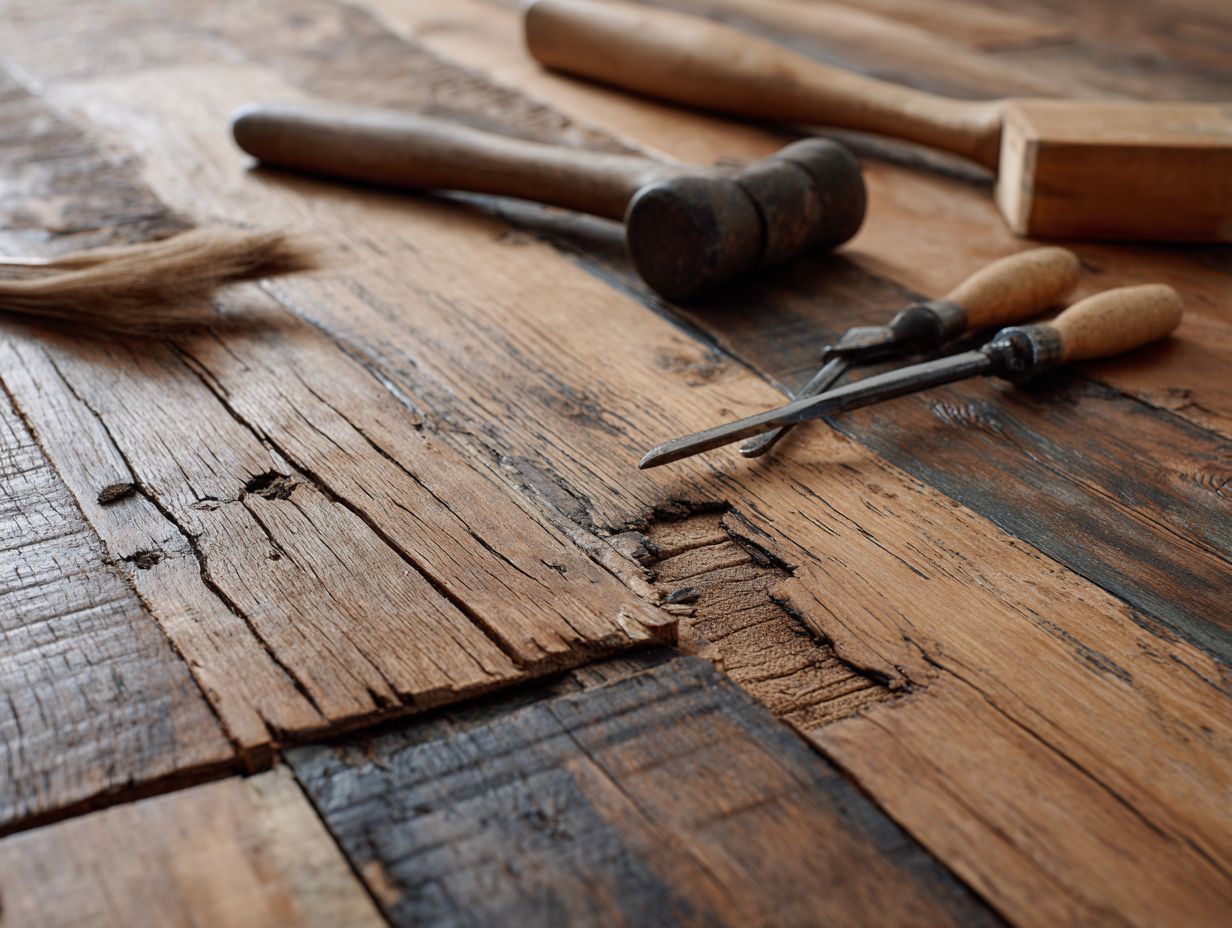
If you still see damage after trying to fix cupping and crowning problems yourself, it’s time to call a professional.
Consider a few specific signs that indicate the need for professional intervention:
- if cracks or chips expand despite repairs,
- if you notice water leakage,
- or if the material feels unusually soft.
A constant or bad smell might indicate a hidden problem. Tools like moisture meters can help check for hidden damage. If your DIY repairs keep failing, it’s best to consult an expert who can thoroughly assess the situation and offer solutions suited to your needs.
Frequently Asked Questions
What is hardwood floor cupping?
Hardwood floor cupping is when the edges of the floor boards are higher than the center, creating a concave shape. This is caused by moisture imbalance between the top and bottom of the boards.
What causes hardwood floor cupping?
The main cause of hardwood floor cupping is excess moisture. This can be from a variety of sources such as leaks, high humidity, or wet mopping. Poor ventilation and improper installation can also contribute to cupping.
Can hardwood floor cupping be fixed?
In some cases, hardwood floor cupping can be fixed by addressing the source of the excess moisture and allowing the boards to dry out and adjust to their natural shape. However, if the cupping is serious, the damaged boards might need to be replaced.
What is hardwood floor crowning?
Hardwood floor crowning is the opposite of cupping, where the center of the floor boards are higher than the edges, creating a convex shape. This is also caused by moisture imbalance but the source of the moisture may differ from cupping.
How can hardwood floor crowning be fixed?
Unlike cupping, hardwood floor crowning can often be fixed by sanding down the higher center boards to match the level of the edges. However, make sure to fix where the moisture is coming from to stop the problem from happening again.
How can I prevent hardwood floor cupping and crowning?
To stop hardwood floors from warping or bulging, keep the humidity in your home balanced, avoid too much water on the floor, and make sure the floors are installed and aired out correctly. Checking for leaks often and fixing them quickly can help stop these problems.
